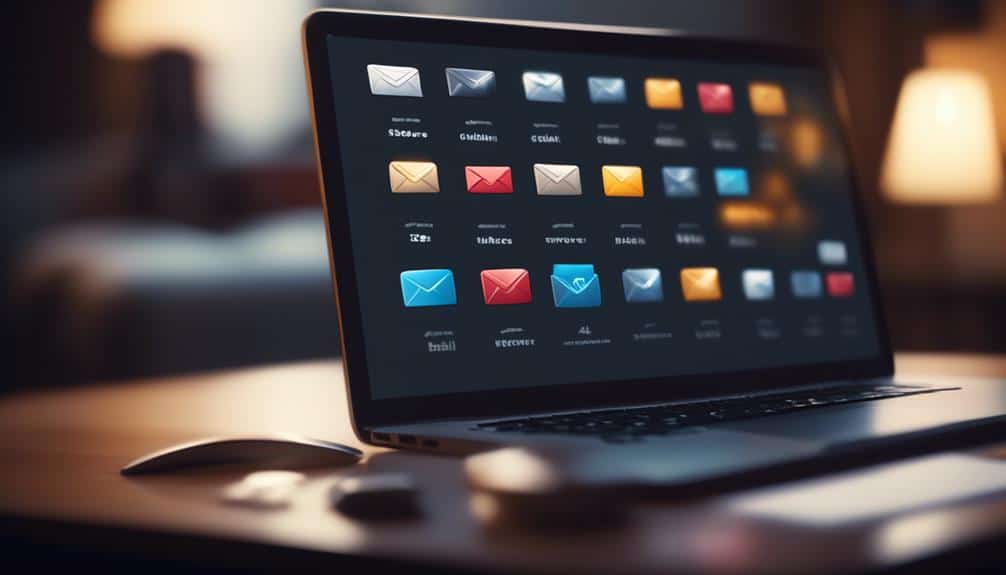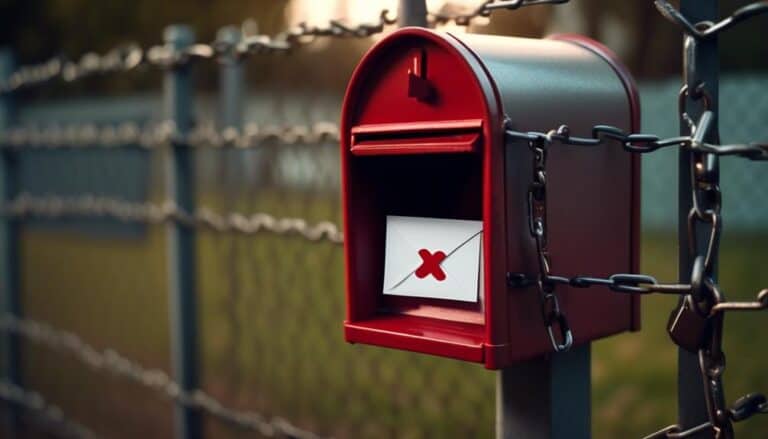Essential Tactics for Handling Unsubscribe Requests Without Losing Engagement
Are you tired of losing subscribers and seeing your engagement plummet? Well, fear not, because there are essential tactics you can employ to handle unsubscribe requests without sacrificing your engagement rates.
In this discussion, we will explore these tactics, from understanding the reasons behind unsubscribe requests to personalizing your communication and providing valuable content. By implementing these strategies, you will not only retain your subscribers but also strengthen their connection to your brand.
So, let's dive in and discover the secrets to maintaining a thriving subscriber base.
Key Takeaways
- Analyze unsubscribe requests to gain insights and identify trends or patterns contributing to subscriber dissatisfaction.
- Offer alternatives to unsubscribing completely, such as adjusting email frequency or allowing subscribers to select specific topics of interest.
- Personalize communication by tailoring email content to individual recipients' interests and needs through segmentation techniques.
- Provide valuable content that addresses the target audience's preferences, interests, and pain points, positioning yourself as a trusted resource.
Understand the Reasons

To effectively handle unsubscribe requests without losing engagement, it's crucial to understand the reasons behind them. Conducting an analysis of unsubscribe requests can provide valuable insights into subscriber preferences, allowing you to tailor your content and avoid future unsubscribes. By examining the data, you can identify common trends or patterns that may shed light on the factors contributing to subscriber dissatisfaction.
Retaining unsubscribed subscribers is also an important consideration. Even though they've chosen to unsubscribe, there may still be opportunities to reconnect and regain their interest. One approach is to reach out to them with a personalized email, acknowledging their decision to unsubscribe and expressing a genuine desire to understand their concerns. By demonstrating your commitment to serving their needs, you may be able to rebuild trust and encourage them to re-engage with your brand.
In addition, analyzing the reasons behind unsubscribe requests can help you improve your overall email marketing strategy. It enables you to identify areas for improvement, such as frequency of emails, content relevance, or email design. By addressing these pain points, you can enhance the subscriber experience and reduce the likelihood of future unsubscribes.
Streamline the Unsubscribe Process
Make unsubscribing from your emails a simple and hassle-free process for your subscribers. To improve efficiency and minimize friction, it's essential to streamline the unsubscribe process.
First, ensure that the unsubscribe link is prominently displayed in every email you send. Make it easily noticeable, preferably at the top or bottom of the email, so your subscribers don't have to search for it.
Additionally, when they click on the link, direct them to a dedicated unsubscribe page that's clear and straightforward. Avoid asking for unnecessary information or making them jump through hoops to complete the process. Respect their decision and make it easy for them to opt-out.
Consider offering alternatives to unsubscribing completely, such as adjusting email frequency or changing preferences. This way, you can retain some level of engagement and keep the door open for future communications.
Also, ensure that the unsubscribe process is fast and automated. Manual or delayed removal from your mailing list can lead to frustration and resentment.
Offer Alternative Options

Consider providing subscribers with alternative options to customize their email preferences. By offering alternative solutions, you can address their concerns and retain their engagement.
Here are some ways you can offer alternative options to meet your customers' preferences:
- Allow subscribers to choose the frequency of emails they receive. Some individuals may prefer daily updates, while others may only want to hear from you on a weekly or monthly basis.
- Provide the option to select specific topics of interest. This way, subscribers can receive relevant content that aligns with their preferences and needs.
- Offer different formats for receiving emails. Some subscribers may prefer a concise newsletter, while others may opt for a more detailed blog post or video.
- Give subscribers the ability to opt-in or opt-out of specific types of communication. For instance, they may want to receive promotional emails but not event invitations.
Personalize Your Communication
When it comes to handling unsubscribe requests without losing engagement, personalizing your communication is key.
Tailored email content that speaks directly to the recipient's interests and needs can help keep them engaged and interested in your messages.
Additionally, offering customized unsubscribe options, such as frequency preferences or alternative content suggestions, allows individuals to have more control over their subscription while still maintaining a connection with your brand.
Tailored Email Content
By tailoring your email content to each individual recipient, you can enhance engagement and foster a more personalized communication experience. This approach allows you to create engaging newsletters that cater to the unique interests and preferences of your subscribers.
To effectively tailor your email content, consider implementing email segmentation, which involves dividing your subscriber list into smaller groups based on demographics, preferences, or past interactions.
Here are four reasons why tailored email content is essential:
- Increased relevance: Personalized emails resonate more with recipients, as they feel understood and valued.
- Higher open and click-through rates: When subscribers receive emails that are tailored to their interests, they're more likely to open them and engage with the content.
- Improved conversion rates: By delivering targeted content, you can guide subscribers towards taking desired actions, such as making a purchase or signing up for an event.
- Enhanced customer loyalty: Tailored emails show that you care about your subscribers' individual needs, fostering a stronger connection and loyalty to your brand.
Customized Unsubscribe Options
To personalize your communication and provide a tailored experience, offer customized unsubscribe options that cater to the individual preferences and needs of your subscribers.
By giving your subscribers the ability to choose their opt-out preferences, you show that you value their preferences and respect their decision to unsubscribe.
Providing different unsubscribe options allows you to gather valuable feedback and insights about why subscribers are choosing to leave. This information can help you improve your future communication and prevent further unsubscribes.
Some subscribers may prefer to receive less frequent emails, while others may want to opt out of specific types of content. By offering unsubscribe preferences, you can better understand your subscribers' needs and deliver a more relevant and engaging experience.
Provide Valuable Content

To keep subscribers engaged and minimize unsubscribe requests, consistently deliver valuable content that meets their needs and interests. By providing content that resonates with your target audience, you can increase engagement and foster a sense of loyalty. Here are some essential tactics to help you provide valuable content:
- Understand your audience:
Take the time to research and understand your target audience's preferences, interests, and pain points. This will enable you to create content that's relevant and valuable to them.
- Create diverse content:
Offer a variety of content formats such as articles, videos, infographics, or podcasts. This allows your subscribers to consume information in the way they prefer and keeps your content fresh and engaging.
- Address their challenges:
Identify the common challenges your audience faces and provide solutions through your content. Offering practical advice and tips will position you as a trusted resource and keep your subscribers coming back for more.
- Personalize your content:
Use segmentation and personalization techniques to tailor your content to specific segments of your audience. This ensures that each subscriber receives content that's highly relevant and valuable to them.
Implement Feedback Surveys
Want to know what your subscribers really think? Implementing feedback surveys is a great way to gather valuable insights and improve your email marketing strategy.
By analyzing the effectiveness of your surveys and optimizing them for maximum engagement, you can better understand your audience's needs and preferences.
This understanding can lead to higher subscriber satisfaction and reduced unsubscribe rates.
Survey Effectiveness Analysis
By implementing feedback surveys, you can effectively analyze the effectiveness of your surveys and improve engagement with your audience.
To ensure accurate analysis and boost survey response rates, consider the following survey design techniques:
- Keep it concise: Shorter surveys tend to have higher response rates as they're less time-consuming for your audience.
- Use closed-ended questions: Multiple choice or rating scale questions are easier to answer and provide quantitative data for analysis.
- Provide incentives: Offering rewards or entry into a prize draw can encourage more people to participate and provide valuable feedback.
- Test and iterate: Continuously refine your survey design based on feedback and data to optimize response rates and engagement.
Feedback Survey Optimization
After analyzing the effectiveness of your surveys and improving engagement with your audience, it's time to optimize your feedback surveys for even better results. One important aspect of feedback survey optimization is the design of the survey itself. A well-designed survey can effectively gather valuable insights from your audience. Consider using a mix of multiple-choice questions, rating scales, and open-ended questions to get a comprehensive understanding of their feedback. Additionally, it's crucial to pay attention to the placement of the unsubscribe button within the survey. Placing it prominently can make it easier for recipients to opt out if they wish to, reducing frustration and increasing trust. Here is an example of how you can optimize your feedback survey design:
| Question | Response Options |
|---|---|
| How likely are you to recommend | 1-10 scale |
| Did you find the content useful? | Yes / No |
| Please share any suggestions | Open-ended text field |
Optimize Email Frequency

To optimize email frequency, consider strategically adjusting the number of emails you send to ensure maximum engagement. By finding the right balance, you can keep your subscribers interested and prevent them from feeling overwhelmed. Here are some essential tactics to help you optimize your email frequency:
- Segment your email list: Divide your subscribers into smaller groups based on their preferences, interests, or behaviors. This allows you to send more targeted and relevant emails, increasing the chances of engagement.
- Conduct A/B testing: Test different frequencies with a subset of your audience to see which one yields better results. This way, you can gather data and make informed decisions about the optimal email frequency for your entire list.
- Monitor engagement metrics: Pay attention to metrics like open rates, click-through rates, and unsubscribe rates. These indicators will help you gauge the effectiveness of your email frequency and make adjustments accordingly.
- Listen to your subscribers: Actively seek feedback from your audience through surveys or direct communication channels. This will provide valuable insights into their preferences and allow you to tailor your email frequency accordingly.
Continuously Improve and Learn
To continuously improve and learn, it is crucial to proactively analyze and optimize your email marketing strategies based on data-driven insights. By constantly evaluating and adjusting your approach, you can ensure that your campaigns are always effective and engaging. Here are some continuous improvement and learning strategies that can help you enhance your email marketing efforts:
| Continuous Improvement Strategies | Learning Strategies |
|---|---|
| Regularly review email performance metrics such as open rates, click-through rates, and conversions to identify areas for improvement. | Stay updated on industry trends and best practices by attending conferences, webinars, and reading relevant publications. |
| Conduct A/B tests to test different email elements such as subject lines, call-to-action buttons, and content layout to determine what resonates best with your audience. | Seek feedback from your subscribers through surveys, feedback forms, or social media to understand their preferences and needs better. |
| Monitor your competitors' email marketing campaigns and analyze their strategies to gain insights and ideas for optimization. | Encourage a culture of learning and innovation within your team by organizing workshops or training sessions focused on email marketing best practices. |
Frequently Asked Questions
How Can I Effectively Understand the Reasons Behind Unsubscribe Requests?
To effectively understand the reasons behind unsubscribe requests, you can start by analyzing feedback and improving communication. By listening to your audience and addressing their concerns, you can enhance your understanding and strengthen your relationship with them.
What Are Some Alternative Options to Unsubscribing From Email Communications?
Looking for alternative options to unsubscribing from email communications? Consider adjusting your opt out preferences. You can reduce email frequency, customize content, or choose specific communication channels that better suit your needs.
How Can I Personalize My Communication to Reduce Unsubscribe Requests?
To reduce unsubscribe requests, personalize your communication. By tailoring your emails to individual interests and needs, you can provide personalized recommendations and benefits that will keep subscribers engaged and less likely to unsubscribe.
What Kind of Valuable Content Should I Provide to Keep Subscribers Engaged?
To keep subscribers engaged, provide valuable content that is interactive and exclusive offers. By creating interactive content, you can keep them involved and interested. Implementing exclusive offers will make them feel special and keep them coming back for more.
How Can Feedback Surveys Help in Handling Unsubscribe Requests and Improving Email Engagement?
Using feedback surveys to gather insights on customer preferences can help you better understand their needs and tailor your content accordingly. This will improve email engagement and reduce unsubscribe requests.
Conclusion
So, there you have it! By understanding the reasons behind unsubscribe requests, streamlining the process, offering alternative options, personalizing communication, providing valuable content, implementing feedback surveys, optimizing email frequency, and continuously improving, you can handle unsubscribe requests without losing engagement.
Remember, keeping your subscribers engaged is crucial for the success of your email marketing campaigns.








